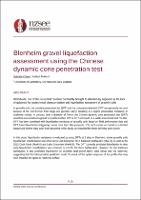Blenheim gravel liquefaction assessment using the Chinese dynamic cone penetration test
Abstract
Worldwide, one of the issues that has been constantly brought to attention by engineers is the lack of guidance for geotechnical characterization and liquefaction assessment of gravelly soils.
In gravelly soils, the standard penetration test (SPT) and the cone penetration test (CPT) are generally not used because of the interference from large-size particles likely resulting in a higher penetration resistance or shallower refusal. In contrast, with a diameter of 74mm, the Chinese dynamic cone penetration test (DPT) would be less sensitive to gravel size particles than SPT or CPT and could be a viable assessment tool. To date, DPT has been correlated with liquefaction resistance of gravelly soils based on field performance data and DPT-based liquefaction-triggering curves have been also proposed. Yet, such curves are based on a limited dataset and further data, such those provided in this study, are required for better defining such curves.
In this study, liquefaction resistance is evaluated by using DPTs at 3 sites in Blenheim, where gravelly soils liquefaction manifestation was observed or not during the 2016 Kaikoura earthquake (Mw7.8) as well as the 2013 Cook Strait (Mw6.6) and Lake Grassmere (Mw6.6). The DPT correctly predicted liquefaction in sites were liquefaction manifestation was observed or not for the three earthquakes. However, for the Kaikoura earthquake, it also predicted liquefaction in stratified sand-gravel layers were ejecta was not observed, suggesting that this false-positive prediction could the result of the system response of the profile that may have impeded the ejecta to reach the surface.

